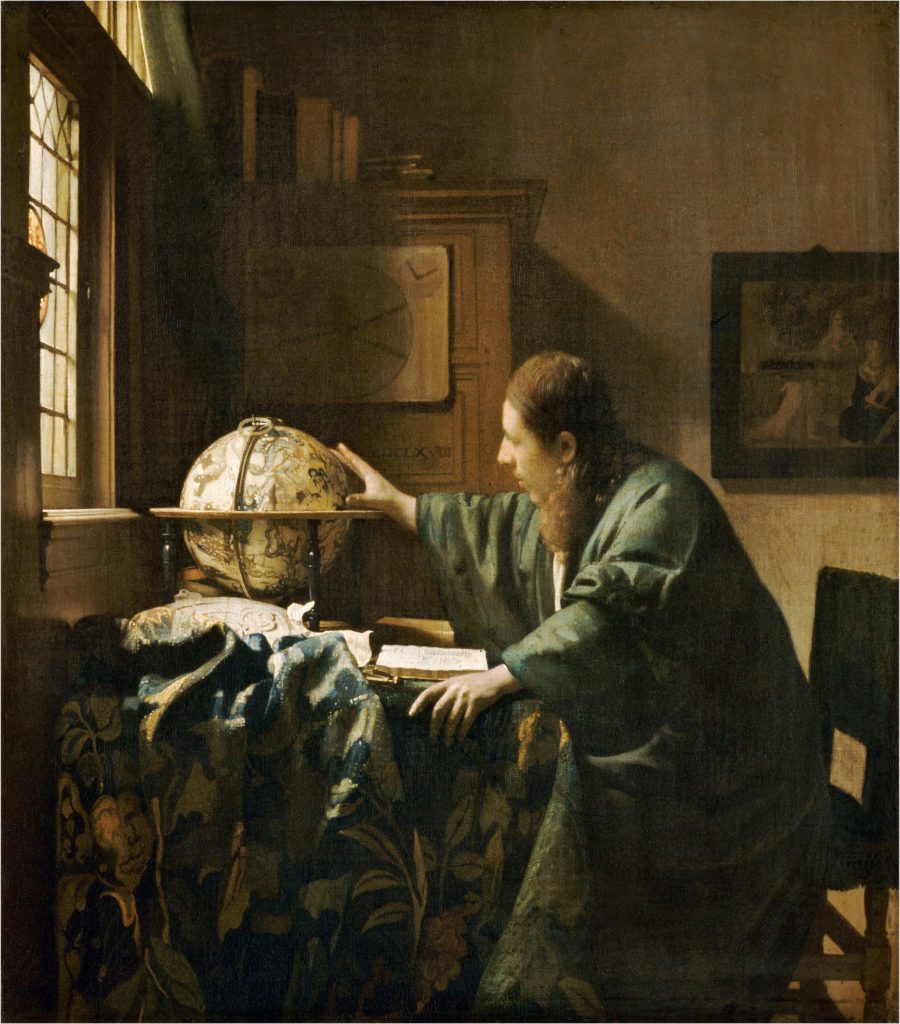Vermeer at the National Gallery
By • December 20, 2017 0 1034

Johannes Vermeer (1632-1675) could manipulate the emotion of light better than any painter I have ever seen. There is a milky, atmospheric delicacy to his best paintings that it is useless to try and describe, a kind of divine inner life he could kindle in his subjects with an effortless, indetectable suggestion of sunlight and shadow.
Early morning light pours through a window and washes across a table like a cool, gentle tide, engulfing the instruments, baubles and arithmetical apparatuses of 17th-century Dutch aristocracy. It falls upon the shrouded face and white fur-lined sleeves of a young woman, the brittle paper and undulating scholarly robes of a geographer, the nimble grip of a lacemaker as she navigates a small constellation of pins and spools between her fingers.
Nearly a third of the painter’s known works — and almost all of his most beloved works — are assembled in “Vermeer and the Masters of Genre Painting,” at the National Gallery of Art through Jan. 21. The opportunity to see so many of Vermeer’s works together in one exhibition is cause for celebration. But to see him in the context of his greatest contemporaries from the Dutch Golden Age is something like a blessing.
The painters Gerard ter Borch, Gerrit Dou, Frans van Mieris and Gabriel Metsu also created works that are not only remarkable, but remarkably similar in style, subject matter and technique. The paintings’ visual connections suggest a robust atmosphere of innovation and exchange.
What this ambitious exhibition explores is to what extent these artists inspired one another — directly or indirectly — and to what extent each followed his own evolution. The similarity of themes, compositions, gestures and poses in so many of these paintings raises
the question of how their creators may have encountered the works of their contemporaries.
The thematic focus of the show, which brings together almost 70 paintings made between about 1655 and 1680, is of course genre paintings, scenes of daily life, a sort of Dutch pre- Impressionism from the third quarter of the 17th century. Made during a time of unparalleled innovation and prosperity, these exquisite portrayals of refined Dutch society — elegant men and women writing letters, playing music and tending to their daily rituals — present a genteel world that is undeniably appealing.
Among the artists other than Vermeer, Metsu is truly a standout. In his best works, his knack for light, body posture, expression and the luscious textures of fabrics and ornamental fixtures rivals Vermeer’s. “Man Writing a Letter” is on par with Vermeer’s “The Geographer” and “Woman Holding a Balance.”
But ultimately, it is very difficult to avoid the magnetism of Vermeer — not that you need to. Sometimes a painter comes along that overshadows all others in his orbit. And this stunning show has every Vermeer you could hope to see.
Something interesting happens when you are drawn to a Vermeer painting in a room full of similar works. If you go up to the other works and scrutinize them closely, they are virtually indistinguishable for quality — gorgeous and richly realized, focusing brilliantly on details of setting and environment.
But as you step back, many of the paintings begin to fall apart, as if the full paintings are not as strong as the sum of their parts. The only true exception to this rule is Vermeer. About 10 feet back from one of his paintings — if you can get that far back without someone stepping in front of you — is where Vermeer overtakes his rivals.
There is often talk about Vermeer’s use of a camera obscura and other pre-photographic
instruments to achieve these ethereal effects. The evidence is clear in the research and literature that continue to develop.
However, this was not what made his paintings masterpieces. Like any tools in the hands of a master technician, Vermeer used a camera obscura to facilitate the pursuit of his vision. I have used a makeshift camera obscura. I dare anyone to try it. I have used grids, graphing instruments and traced photographs in my own pursuit of art. I promise you, they do not guarantee a successful painting.
I don’t know how many of his contemporaries used a camera obscura. But I can tell you this: There is a floating wall in the center of the main gallery with three paintings on it. On either side are “The Geographer” and “The Astronomer,” two of Vermeer’s greatest achievements. In between these works hangs Dou’s “Astronomer by Candlelight.” Ultimately, you feel a little bad for Gerrit Dou, sitting in the shadow of Vermeer’s overpowering, masterfully entrancing light.

